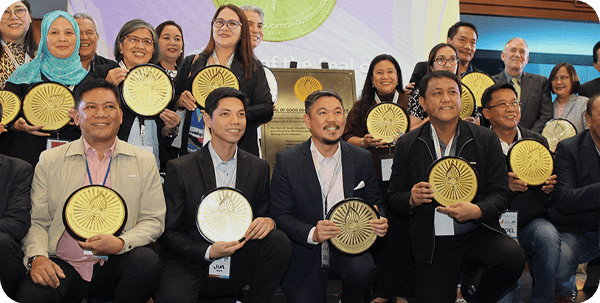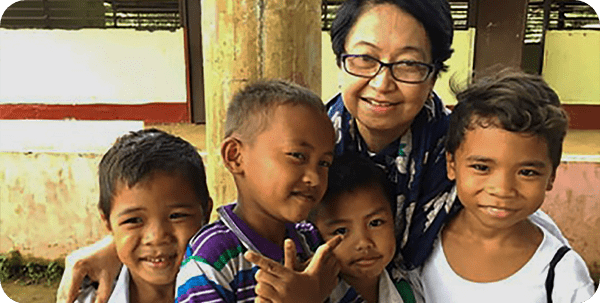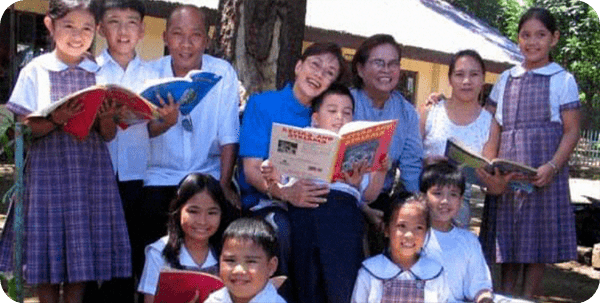On Governing/Implementing Education: Translating Policies into Action
The Philippine education system is rather complex and quite dispersed across a large archipelago and it is quite fragmented, comprised of many multiple moving parts, very diverse. We have one Department of Education but it is being implemented in 17 regions, and each of the regions is divided into about 8 to 14, 15 school divisions. So, we have about 225 across the country, and each of the school divisions has quite a number of school districts, about 2,200 all over the country, 62,000 public schools, about 8,500 private schools, over 900,000 public school teachers, or about a million if you add the private school teachers.
It is a complex system and, on top of that, we have an autonomous region in Bangsamoro Autonomous Region in Moslem Mindanao, which is not under the Department of Education but which functions like the Department of Education.
If you take a look at the system, there are what I call creative tensions and I say “creative” rather than “destructive” tensions. They are actually good for the system, but if you don’t manage them properly, they can get out of control.
The first tension is centralized control over the entire system versus decentralized operations. Standards are set at the central office but the interpretation of the standards are done in the regions. As a result, you can have different interpretations of what those standards can be. So there is tension, division, between the DepEd central office and the regions in this regard.
There is also tension between the Department of Education and local stakeholders, such as the local governments, who do not report to the Department of Education but where the local school boards, for example, are controlled. The local school boards are part of the local governments and so they can, they should, follow what the Department of Education is mandating or saying. However, that’s not necessarily always the case. So there is that tension between local governments and the Department of Education.
I will explain.
Local context matters. There are a lot of demographic, socio-economic, socio-political situations on the ground in a particular place or locality, which can have an impact or effect on education.
The first is income class disparities that continue today. So, if you take a look:
The poor-to-low-income classes are about 40.5% of the population, of all families.
Lower middle-income is about 36% of all families.
Middle-middle to upper middle-income is about 20.7% of all families.
And the upper income and rich only account for about two and a half percent of all families.
This context will have an impact because the low-income and the lower middle-income families are the ones who are, in terms of equity, the most disadvantaged, and so their numbers tend to be lower in terms of participation, compared to the higher income groups.
The second tension is with reference to ethnicity and language. If you take a look at the country, the Department of Education has recognized 19 language groups, so in the very early years, the mother tongue instruction is done in those local language groups before it transitions to English and Filipino, which is the national language. You can imagine the tension here because kids in the many outlying areas do not speak English or Filipino as the language at home. They speak their local language or dialect. Then, you have local norms and this is especially among the very rural remote areas and certain indigenous communities, where you have child marriage, for example, which takes kids out of school. And in very, very poor communities, you have child labor, which also takes kids out of school. These are some of the contexts that we have to be aware of in terms of policy recommendations.
Let me say a few things about policy setting. When you set a policy, you are setting a direction for everybody. Once you set that policy, it applies to all, so we want a policy that benefits the vast majority of society. Even with the best policy, you will have gainers, you will have losers. The key is to have the gainers far outnumber the losers or those who are losing. You want to make sure that the value of the loss is not too large that it will cause problems in implementation even if they are the minority. Remember, in situations where you have losers, especially very vocal losers, the vocal minority can lead a revolt and this can cause problems for everybody in the system.
If there are losers in the system, you want to make sure that there is a way by which you can pick up the losers, especially those who fall along the margins or fall between the cracks. And here, you use affirmative action programs to pick these groups up. The policy applies to everybody but the affirmative action program can be targeted to certain groups to make sure that these groups can be picked up and brought back to the system.
The other thing is you have the structurally disadvantaged. Here, you have structural barriers in society that can exclude groups wittingly or unwittingly. Here are some examples. In the Philippines, we have what is called GIDA (Geographically Isolated and Disadvantaged Areas). These are areas which are so remote that they tend to be forgotten and left out of the system. So, the Department of Education, a couple of years ago, articulated a program called “Last Mile Schools” to try to reach out to these communities to make sure that schooling, education services were available to them.
Unfortunately, GIDA or “Last Miles” areas are also the most expensive to reach on a per capita basis. One, is because they are isolated. Two, because they have no infrastructure, so you have to develop that infrastructure. Or you may not have the human resources. You have to move human resources out there and not everybody wants to move to isolated areas, so this can be very expensive but needs to be done. Unfortunately, in this pandemic, it has been put on the backburner and we have to get back to it because there are a few thousand schools or quite a few areas where this is a problem.
Then, you have historically discriminated communities. An example of this would be the Moslem-Filipinos. We are a predominantly Catholic Christian nation and, historically, the Moslem-Filipino population has been discriminated or left out. That is why there is an autonomous region dealing with this, where the Moslem-Filipino population is the majority. We need to be constantly aware of this because there are Moslem-Filipino communities in the general area not within the autonomous region.
Then, we have the migrant worker communities. These are communities that move around and, because they move around, they tend not to have basic social services, including education, and they tend to be discriminated and left out. We need to make sure that we are always aware of this.
Let me go to this pandemic. The Philippine government closed all schools at all levels to face-to-face instruction on March 2020. This is the longest closure in the world, I believe, certainly in Southeast Asia. What’s happened, in fact, it’s only last week that a handful of schools, 100 public schools and 20 private schools, were allowed to open face to face instruction. This is a drop in the bucket compared to the total number of schools, which is about 62,000 schools all over the country. The government has allowed these schools to open face-to-face on a limited, pilot basis. The reality of it is all the other schools had to continue distance learning. And the problem is, when this happened last year and up to today, the Department of Education, the schools, and the communities were not ready for distance learning.
The second reality, and this is what I want to point out, is large parts of the country have zero or very few COVID 19 cases. The question I have is, why shut down areas with no or few COVID cases because the National Capital Regions and the neighboring areas or large metropolitan areas have numerous cases? Or, why is there a one-size-fits-all policy? It doesn’t make any sense. We could have learned from the rest of ASEAN, where schools have been opened for many months, over a year, and in some countries, continue to do aggressive testing, set up protocols, shut down schools and quarantine them if COVID cases occur, and are starting to vaccinate teachers and students. So, there are ways. Other countries have done it, so why couldn’t the Philippines do it? I think this is a real shortcoming in terms of our policy.
Thank you.




